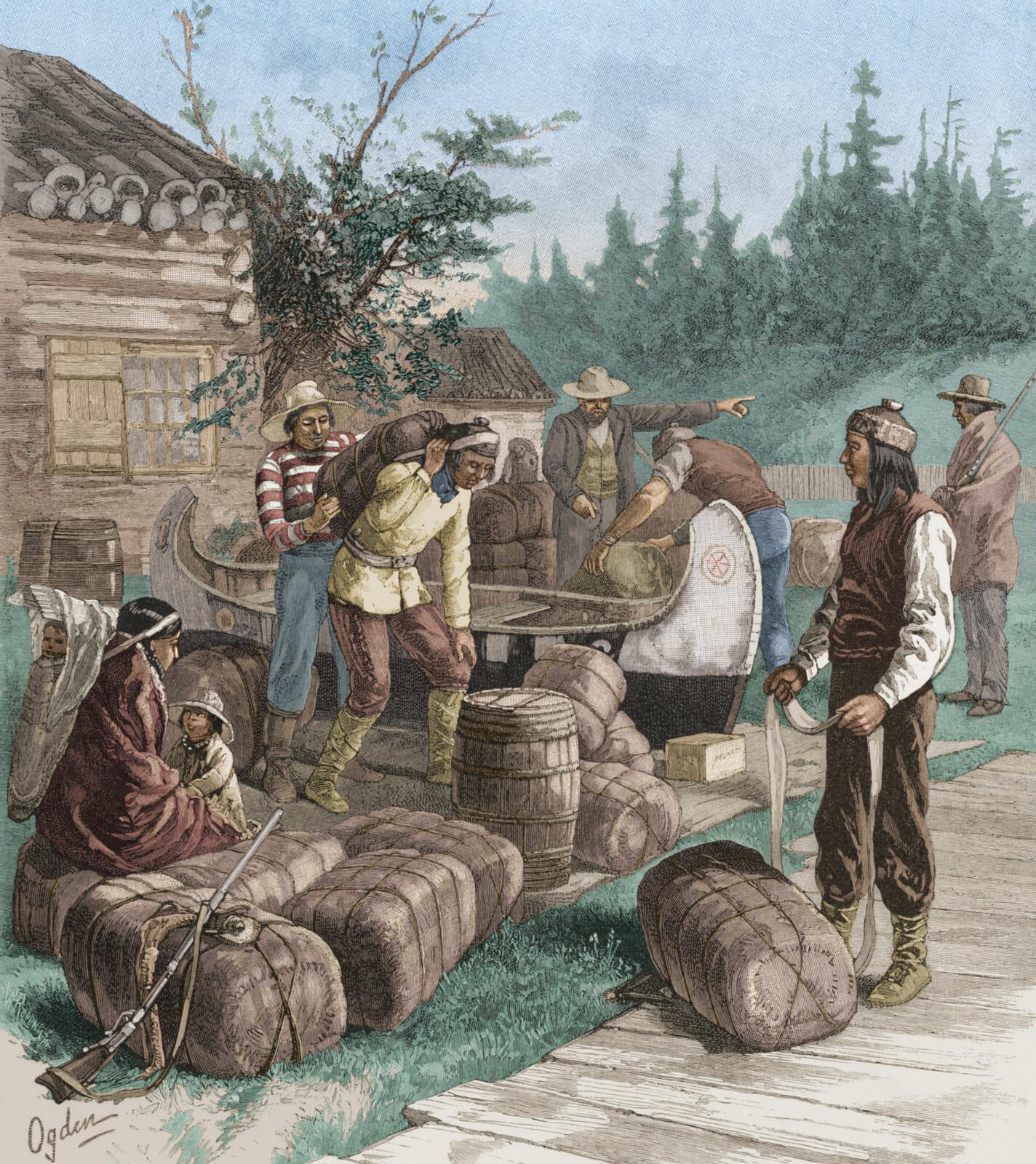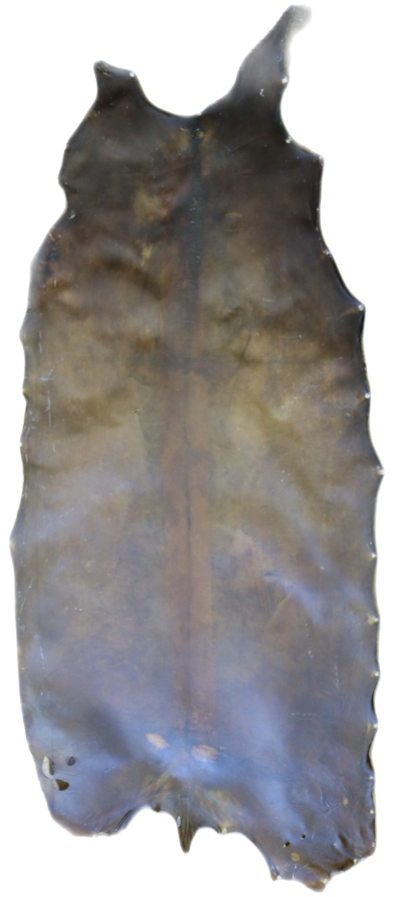No Products in the Cart
This article will describe the how and why of Pemmican storage, based on history, chemistry, and our own experiences. For long-term storage, DO NOT simply close your Pemmican back up in the pouch it came in - the stagnant air can cause it to get moldy.
 Average 18th-century Pemmican-enjoyers.
Average 18th-century Pemmican-enjoyers.
The history of the fur trapping industry in the great northwest is full of legendary heroes. There’s Jim Bridger, the mountain man who used to end his tall tales with “and then, they killed me!” Then there’s Jedediah Smith, who lost half his scalp to a grizzly bear.
But to our mind, the toughest character from that history is the “Rawhide Piece” of buffalo Pemmican.

Buffalo Rawhide Bags - optimal for Pemmican storage.
Pemmican was traditionally stored as 90-pound "pieces" that filled up a rawhide bag, sown up with sinew, with the seams coated in tallow.
Stored like that, a rawhide piece of Pemmican could remain pristine through all kinds of conditions: heat, cold, rain, and sun, for years or even decades.
But nowadays, the USDA doesn't take kindly to rawhide storage.
Here's what we recommend:
-Option 1: Keep your Pemmican Vacuum-sealed. (No air.)
Once you open up your Pemmican, vacuum-seal it again, within a week or so. Make sure you get all of the air out.
-Option 2: Store your Pemmican with air openings. (Air flow.)
If you don’t have a vacuum sealer: Once you open up your Pemmican, you may place it in a paper bag, or a plastic bag with perforations, so that fresh air can flow in and prevent mold from growing. This works well in a refrigerator, because a) that is an extremely dry environment, b) rodents (hopefully) won’t threaten your Pemmican, in there, and c) the cold tallow will not melt and get the paper bag greasy. (NOTE: do not store your Pemmican sealed, but not vacuumed, in the fridge. See below.)
-Option 3: Open up your Pemmican at least once per day. (Air flow.)
If you’re out on the go, and you are gradually eating down a Pemmican brick, you will achieve sufficient air flow if you open the Pemmican package a few times, daily, as you will naturally, if you’re eating Pemmican often. When you do close the Pemmican bag, try to push out as much air as possible.
-Option 4 (Bonus Points): Craft a rawhide bag and melt your Pemmican into it.
Métis style. Send us a picture and we’ll feature your epic 19th-century style.
-Do not re-seal your Pemmican in its original bag (or any airtight plastic bag) with stagnant, moist air inside the bag. This is a recipe for mold on any organic substance, not just Pemmican. (This applies even in a refrigerator. (But frozen and un-vacuumed would be fine.))
 Métis people collecting large pieces of Pemmican and other goods, for a Hudson Bay Co. trapping expedition.
Métis people collecting large pieces of Pemmican and other goods, for a Hudson Bay Co. trapping expedition.
***
For long journeys or long storage, Pemmican is far superior to jerky and other meat products. But it is possible for Pemmican to spoil, if it is stored improperly.
There are two factors that cause Pemmican spoilage: air and water. Out of these two, air (especially humid air) is by far the most important.

Stagnant air - never good, for people nor Pemmican.
1) Air and Pemmican - Go for “No Air, or Air Flow.”
Stagnant air, which contains moisture and oxygen, will enable mold to grow on nearly any organic surface. That even includes beef tallow, which has potent anti-microbial properties. The main principle of Pemmican preservation is avoiding stagnant air.
To preserve Pemmican, keep these words in mind: “No or Flow.” Here are your options:
-No Air.
You can completely vacuum out all of the air in your Pemmican package — this is how we package our Pemmican. A similar effect can also be achieved with “Oxygen Grabber” packets that have iron that absorbs all the oxygen in an enclosed area.
-Air Flow.
You can store your Pemmican in paper bags and open-ended plastic bags, or in unsealed plastic cups, for months on end. Refrigeration is a bonus. Protect from rodents.

Water condensation on glass, from humid air.
A similar thing can happen to Pemmican.
If you’ve ever rendered beef tallow, then you know how hard it is to clean up, once it cools down and solidifies. The fact is that beef tallow is extremely hydrophobic. The tallow is is what gives Pemmican a distinct advantage over beef jerky, which will absorb any humidity present in the air.
Pemmican, on the other hand, is not porous. The rendered fat in Pemmican seals the pores in the dry meat, so that humid air can’t moisten the meat. This is why the Pemmican stored in the rawhide stayed good in the rain, all those years ago - it got wet, but the water didn’t permeate the Pemmican. When the air dried up again, the rawhide and the Pemmican dried off, too.
(Even when, in stagnant, humid environments, mold grows on Pemmican, it generally only ever grows on the surface, where the water and oxygen are. A millimeter or two below, inside the Pemmican, everything is all good.)

Bison rawhide - the original Pemmican storage material.
The traditional mode of Pemmican production was to stuff a rawhide bag full of shredded jerky, and then to pour rendered liquid fat into the bag, until it was full. Then it would be sewn up tight with sinew. Once the fat cooled down and solidified, the Pemmican would have almost no exposure to air. It was like an old-fashioned vacuum seal.
Because it isn't waterproof, rawhide is a poor storage material for jerky, which will rot when exposed to liquid. However, as we noted above, liquid water is not much of a problem for Pemmican — the real problem is humid, stagnant air where mold can grow.
Even when rawhide got wet, the Pemmican inside would be fine, because the tallow would repel the water, and the rawhide would seal out the air.
(Sidenote: the fact that wet rawhide Pemmican didn’t spoil suggests that Pemmican could perhaps be stored well underwater... maybe. As long as the water was cold enough that the tallow wouldn’t begin to soften or melt. We’re experimenting on that…)

We have examined several specimens of moldy Pemmican. And we’ve found that the mold has not penetrated even a millimeter below the surface of the Pemmican. So, if you’re in an emergency situation, and the surface of your Pemmican is moldy… we totally don’t (wink) recommend that you cut into it and see if the interior of the Pemmican is still fresh and tasty. Again, for legal reasons, we cannot recommend that you check whether the interior of your Pemmican is still fresh and nutritious.
Thank you so much for a good clear understanding of how to prepare this meat product. You have our best interest at heart.
I’m a teacher, and work at helping my students to and understand how to see and learn
Progresses.
Dave Gibson.
Thanks
“Pemmican didn’t spoil suggests that Pemmican could perhaps be stored well underwater… maybe” -
There’s an expression that goes, “Everything’s been invented before us.”
For storing butter in water, you can look at French Butter Keeper.